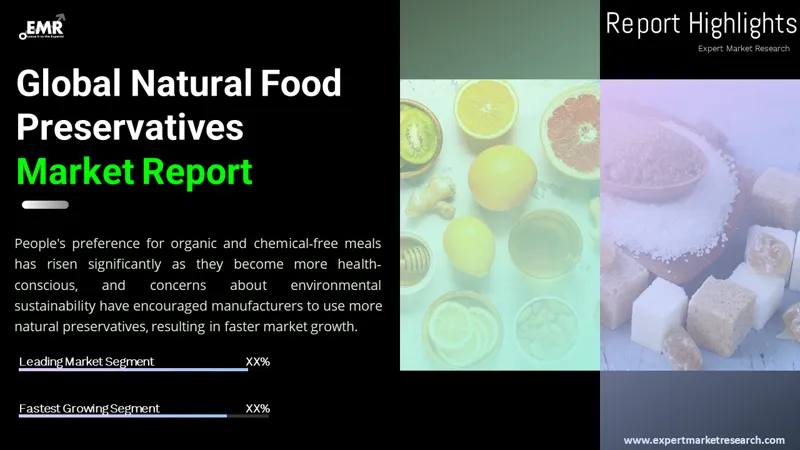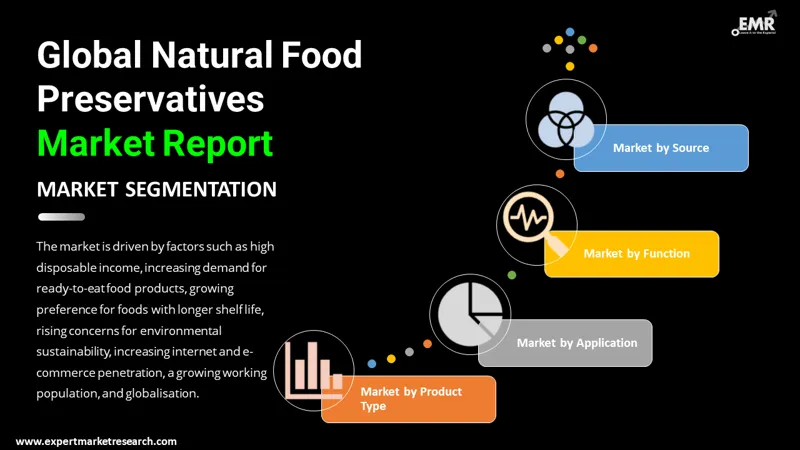
Consumer Insights
Uncover trends and behaviors shaping consumer choices today
Procurement Insights
Optimize your sourcing strategy with key market data
Industry Stats
Stay ahead with the latest trends and market analysis.
The global natural food preservatives market attained a value of USD 622.33 Million in 2025. The market is further expected to grow in the forecast period of 2026-2035 at a CAGR of 5.40%, to reach USD 1053.00 Million by 2035.
Base Year
Historical Period
Forecast Period
Compound Annual Growth Rate
5.4%
Value in USD Million
2026-2035
*this image is indicative*
Natural food preservatives refer to the preservatives which are free from synthetic components and are obtained from different natural sources such as vitamin C, vinegar, spices, and plant extracts, among others. These preservatives help in the prevention of food spoilage by actions such as inhibiting oxidation and preventing microbial action that can damage the food or beverage quality.

Read more about this report - REQUEST FREE SAMPLE COPY IN PDF
Global Natural Food Preservatives Market Report and Forecast 2026-2035 offers a detailed analysis of the market based on the following segments:
Market Breakup by Source
Market Breakup by Product Type
Market Breakup by Function
Market Breakup by Application
Market Breakup by Region

Read more about this report - REQUEST FREE SAMPLE COPY IN PDF
The antimicrobial segment, based on function, accounts for a healthy share of the natural food preservatives market. This can be attributed to the ability of antimicrobial preservatives to preserve food without changing its quality. In addition, these preservatives also offer protection against a wide spectrum of microorganisms. Over the forecast period, the anticipated increase in demand for antimicrobial preservatives in fruits and vegetables, to ensure safety, protection, and to extend shelf life, is propelling the growth of this segment.
The North America region holds a significant share of the natural food preservatives market. Rising demand for meat, increasing application of natural food preservatives in bakeries and confectionery outlets, and rising population across the United States and Mexico, is driving the market for natural food preservatives in the region. Moreover, a heavy consumption of ready-to-eat food products across the region and common purchase of food items in bulk is another major factor bolstering the market natural food preservatives. Rising awareness among consumers in countries such as the United States and Canada is also resulting in an increased demand for natural food preservatives over synthetic food preservatives.
The comprehensive EMR report provides an in-depth assessment of the market based on the Porter's five forces model along with giving a SWOT analysis. The report gives a detailed analysis of the key players in the global natural food preservatives market, covering their competitive landscape and latest developments like mergers, acquisitions, investments and expansion plans.
Kemin Industries, Inc. is a global ingredient manufacturer which produces and sells products related to pets, aquaculture, nutraceuticals, crop technology, and textiles, among others. Founded in 1961, the company is headquartered in Iowa, United States.
Cargill, Inc. is a leading food corporation which produces and markets products and services related to financial, agricultural, and industrial fields. The company was established in 1865 and is headquartered in Minnesota in the United States.
ITA 3 s.r.l. is a renowned food company which delivers natural food additives, with a product portfolio that includes mould inhibitors, emulsifiers, and antioxidants. The company was founded in 1980 and is currently headquartered in Lombardy, Italy.
*Please note that this is only a partial list; the complete list of key players is available in the full report. Additionally, the list of key players can be customized to better suit your needs.*
Other market players include BASF SE, Corbion N.V., and Merck KGaA, among others.




*While we strive to always give you current and accurate information, the numbers depicted on the website are indicative and may differ from the actual numbers in the main report. At Expert Market Research, we aim to bring you the latest insights and trends in the market. Using our analyses and forecasts, stakeholders can understand the market dynamics, navigate challenges, and capitalize on opportunities to make data-driven strategic decisions.*
Get in touch with us for a customized solution tailored to your unique requirements and save upto 35%!
The market is estimated to grow at a CAGR of 5.40% between the 2026 and 2035.
The market is estimated to witness a healthy growth in the forecast period of 2026-2035, reaching a value of around USD 1053.00 Million by 2035.
The major drivers of the market include increasing demand for natural ingredients in food and beverages, rising disposable income, growing demand for convenience foods, and increasing demand for foods and beverages with extended shelf life.
The key trends of the market include the rising popularity of e-commerce, increasing demand for clean-labelled natural food products, expansion of major food processing firms, and increase in demand for meat, dairy, and bakery products.
The different sources of natural food preservatives in the market are microbial, plant, mineral, and animal.
The significant product types of natural food preservatives in the market are oil, honey, salt, sugar, citric acid, and vinegar, among others.
The various applications of natural food preservatives in the market are dairy, snacks, bakery, fruits and vegetables, beverages, and sea food, meat, and poultry, among others.
The key market players, according to the report, are Kemin Industries, Inc., Cargill, Inc., ITA 3 s.r.l., BASF SE, Corbion N.V., and Merck KGaA, among others.
Explore our key highlights of the report and gain a concise overview of key findings, trends, and actionable insights that will empower your strategic decisions.
| REPORT FEATURES | DETAILS |
| Base Year | 2025 |
| Historical Period | 2019-2025 |
| Forecast Period | 2026-2035 |
| Scope of the Report |
Historical and Forecast Trends, Industry Drivers and Constraints, Historical and Forecast Market Analysis by Segment:
|
| Breakup by Source |
|
| Breakup by Product Type |
|
| Breakup by Function |
|
| Breakup by Application |
|
| Breakup by Region |
|
| Market Dynamics |
|
| Competitive Landscape |
|
| Companies Covered |
|
| Report Price and Purchase Option | Explore our purchase options that are best suited to your resources and industry needs. |
| Delivery Format | Delivered as an attached PDF and Excel through email, with an option of receiving an editable PPT, according to the purchase option. |
Datasheet
One User
USD 2,499
USD 2,249
tax inclusive*
Single User License
One User
USD 3,999
USD 3,599
tax inclusive*
Five User License
Five User
USD 4,999
USD 4,249
tax inclusive*
Corporate License
Unlimited Users
USD 5,999
USD 5,099
tax inclusive*
*Please note that the prices mentioned below are starting prices for each bundle type. Kindly contact our team for further details.*
Flash Bundle
Small Business Bundle
Growth Bundle
Enterprise Bundle
*Please note that the prices mentioned below are starting prices for each bundle type. Kindly contact our team for further details.*
Flash Bundle
Number of Reports: 3
20%
tax inclusive*
Small Business Bundle
Number of Reports: 5
25%
tax inclusive*
Growth Bundle
Number of Reports: 8
30%
tax inclusive*
Enterprise Bundle
Number of Reports: 10
35%
tax inclusive*
How To Order

Select License Type
Choose the right license for your needs and access rights.

Click on ‘Buy Now’
Add the report to your cart with one click and proceed to register.

Select Mode of Payment
Choose a payment option for a secure checkout. You will be redirected accordingly.
Gain insights to stay ahead and seize opportunities.

Get insights & trends for a competitive edge.

Track prices with detailed trend reports.

Analyse trade data for supply chain insights.

Leverage cost reports for smart savings

Enhance supply chain with partnerships.

Connect For More Information
Our expert team of analysts will offer full support and resolve any queries regarding the report, before and after the purchase.
Our expert team of analysts will offer full support and resolve any queries regarding the report, before and after the purchase.
We employ meticulous research methods, blending advanced analytics and expert insights to deliver accurate, actionable industry intelligence, staying ahead of competitors.
Our skilled analysts offer unparalleled competitive advantage with detailed insights on current and emerging markets, ensuring your strategic edge.
We offer an in-depth yet simplified presentation of industry insights and analysis to meet your specific requirements effectively.
Share